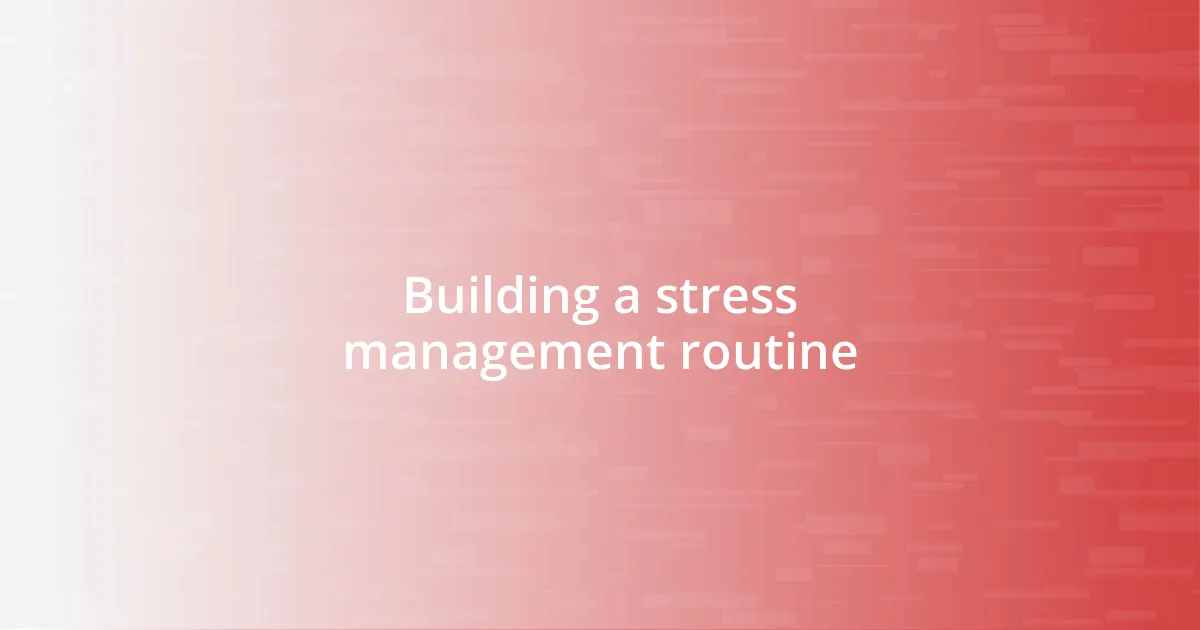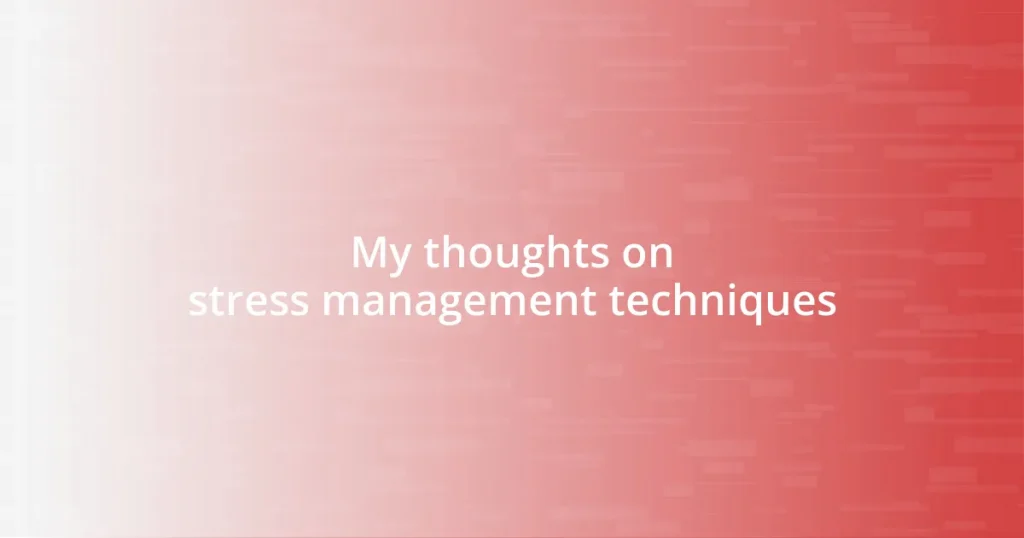Key takeaways:
- Stress affects individuals differently, influencing both physiological responses and mental well-being.
- Identifying personal stress triggers through introspection, such as maintaining a stress journal, can help manage stress effectively.
- Incorporating relaxation techniques, like deep breathing and mindfulness meditation, are essential for stress relief.
- Engaging in regular physical activity not only reduces stress but also fosters community and connection with others.

Understanding stress and its impact
Stress is an inevitable part of life, but its impact can vary widely from person to person. I remember a time when I felt overwhelmed with work deadlines; during that phase, I hardly slept, which affected my mood and decision-making. Have you ever noticed how stress clouds your judgment or saps your energy?
The physiological effects of stress can be just as troubling. Increased heart rate and a feeling of tightness in your chest are not just signs of anxiety; they signal your body’s fight-or-flight response kicking in. I experienced this firsthand during a challenging presentation, where my body reacted without my consent—adrenaline surged, and suddenly I was in a heightened state of alertness, but it felt utterly exhausting.
Understanding stress isn’t just about recognizing its symptoms; it’s about grasping its intricate connection with our well-being. Have you considered how prolonged stress can contribute to chronic health issues? Reflecting on my experiences, I can’t help but acknowledge that my stress seemed to amplify both my physical tensions and emotional struggles, creating a vicious cycle that affected my daily life.

Identifying personal stress triggers
Identifying personal stress triggers requires introspection and honesty. I recall when I began to notice that sudden changes in my schedule left me feeling restless and on edge. It was as if I’d built a fortress of comfort and predictability, only for it to come crashing down with an unexpected meeting or a last-minute obligation. By taking the time to pinpoint what exactly disrupts my flow, I found deeper insights into my emotional state and how specific scenarios could push me towards stress.
Keeping a stress journal proved invaluable in my journey toward understanding my triggers. I documented moments when I felt overwhelmed, noticing patterns over time. For instance, I discovered that loud environments and conflicts with colleagues significantly escalated my anxiety. Recognizing these stressors allowed me to prepare better, whether that meant planning quiet time at home or seeking resolution in a professional disagreement.
In stretching beyond the obvious, I’ve learned that underlying issues often contribute to stress. Sometimes, it’s the small, seemingly insignificant things that accumulate into a larger sense of unease. I once thought I could brush off my discontent about work-life balance; however, when I examined my feelings more closely, I realized that my constant juggling between personal and professional duties was a significant stress contributor. This realization was a pivotal step in learning to manage my stress holistically, addressing not just the immediate but the foundational causes in my life.
| Type of Trigger | Example |
|---|---|
| Environment | Loud offices or crowded places |
| Work-related | Last-minute meetings or deadlines |
| Interpersonal | Conflicts with colleagues or family |
| Routine disruptions | Changes in daily schedules or plans |

Practical techniques for relaxation
Relaxation techniques are essential tools in combating stress, and I’ve stumbled upon several methods that truly enhance my sense of calm. For instance, I discovered the power of deep breathing exercises during a particularly hectic day; taking a moment to breathe slowly and intentionally helped shift my focus from chaos to peace. I find that grounding myself through these techniques can be a game-changer when stress levels rise.
- **Deep Breathing:** Inhale for a count of four, hold for four, exhale for four. This simple practice can instantly lower anxiety.
- **Progressive Muscle Relaxation:** Tense and then relax each muscle group, starting from your toes and moving up to your head, helps release built-up tension.
- **Visualization:** Close your eyes and imagine a tranquil setting, like a beach or forest; this mental escape fosters relaxation.
- **Mindfulness Meditation:** Focusing on the present moment, recognizing thoughts without judgment, can significantly ease the racing mind.
Another practical technique is engaging in regular physical activity, something I often rely on. I remember feeling rejuvenated after a brisk walk during my lunch break; it’s remarkable how moving my body shifts my mood. This kind of activity doesn’t have to be intense; even gentle stretching or yoga can work wonders in releasing built-up stress and enhancing overall relaxation.
- **Walking:** A simple stroll can clear the mind and boost mood, especially in nature.
- **Yoga:** Combining breath with movement not only strengthens the body but calms the mind.
- **Dancing:** Whether it’s in your living room or a class, dancing can be a joyful way to shake off stress.
- **Tai Chi:** This gentle martial art promotes relaxation through slow and deliberate movements.

Building a stress management routine
Building a stress management routine isn’t just about picking a few techniques off the shelf; it’s about creating a personalized approach based on what resonates with you. For instance, I’ve found that dedicating specific time slots each day for relaxation activities, like a calming yoga session or quiet reading, has made a considerable difference in how I handle stress. When I set that time aside, it feels like I’m prioritizing my mental health, which in turn empowers me to face daily challenges with a clearer mind.
Incorporating elements that excite you into your routine can also be a game changer. I’ll never forget when I decided to combine my love for music with relaxation techniques; I created a playlist specifically for moments of anxiety. Listening to those soothing melodies while practicing mindfulness helped me center myself like nothing else could. Have you ever tried to forge that connection with something you love? It can deepen the experience and make stress management feel less like a chore and more like self-care.
As I built my routine, I discovered that consistency is key. It can be easy to drift away from practices that help, especially during busy periods. There was a time when I stopped setting aside morning moments for deep breathing, and I felt the rush of stress creep back in. It reminded me of how significant those small practices truly were. I encourage you to reflect on what works for you, and don’t hesitate to adjust your routine as life unfolds. Seeing stress management as an evolving journey rather than a fixed regimen has helped me feel more flexible and resilient.

The role of physical activity
Engaging in physical activity plays a vital role in managing stress, something I’ve experienced firsthand many times. I remember a particularly overwhelming week when my workload seemed never-ending. After one evening spent dancing in my living room, I felt an immediate sense of relief as if the stress had melted away with each move. It’s astonishing how rhythm can invigorate both body and mind, don’t you think?
Moreover, the science behind this effect is compelling. Exercise releases endorphins, those delightful little hormones that act as natural mood lifters. I often find that a quick workout or even a leisurely bike ride leaves me calmer and more focused. Just the other day, I took a scenic route through my neighborhood and realized how the fresh air and sunshine uplifted my spirits. Have you ever noticed how nature can be the best backdrop for relieving stress?
What’s fascinating is that it doesn’t always require a gym membership or an intense workout regimen to feel the benefits. Gentle movements, like yoga or tai chi, allow for an intimate connection between mind and body, and I deeply appreciate those moments of mindfulness. One time, I attended a local yoga class and couldn’t help but feel a sense of community among the participants. Sharing that space, focusing on our breath together, created a comforting atmosphere that brought us closer, reinforcing the idea that we’re all in this journey of managing stress together. How do you integrate physical activity into your routine to foster similar connections?

Incorporating mindfulness practices
Incorporating mindfulness practices into my daily routine felt like discovering a hidden treasure. One evening, after a particularly hectic day, I sat in a quiet corner of my home, closed my eyes, and focused on my breath. As I tuned into the gentle rhythm of inhaling and exhaling, I realized how quickly my racing thoughts began to settle. Have you ever noticed how just a few minutes of intentional breathing can transform your mindset?
I also cherish moments of mindful walking. Instead of rushing through my daily errands, I started to pay attention to my surroundings—the vibrant colors of the flowers, the breeze against my skin, and even the sounds of laughter from nearby children. One sunny afternoon, I savored a stroll through the park, and every step felt vibrant and alive. It’s incredible how being present in the moment makes the most mundane activities feel refreshingly new, don’t you think?
On another occasion, I embraced the practice of gratitude during my mindfulness sessions. I began writing down three things I appreciated each day. This simple exercise shifted my perspective, allowing me to focus on the positives rather than what stressed me out. I remember feeling a sense of warmth in my heart as I recognized the support system of friends and family around me. It’s really about finding those little sparks of joy, isn’t it?

Evaluating the effectiveness of techniques
Evaluating the effectiveness of stress management techniques can be quite enlightening. I often find myself reflecting on which methods truly resonate with me. For instance, I tried a breathing exercise I found online during a particularly stressful period, and after just five minutes, I felt my tension easing. Have you ever discovered a simple practice that surprisingly brought you immense relief?
When I think about the traditional techniques—like journaling or meditation—I realize their impact is often deeply personal. I recall one time I dedicated ten minutes each morning to jot down my thoughts and feelings. It was as if the words flowed like a river, carrying away the weight of my worries. The clarity I gained from that exercise was both surprising and refreshing. Do you have practices that help clear your mind in a similar way?
It’s essential to measure the effectiveness of these techniques over time, too. I remember incorporating regular weekly check-ins with myself to assess my stress levels after introducing yoga into my routine. Gradually, I noticed my ability to face challenges increased, making me feel empowered rather than overwhelmed. This journey of self-evaluation is crucial, don’t you think?















